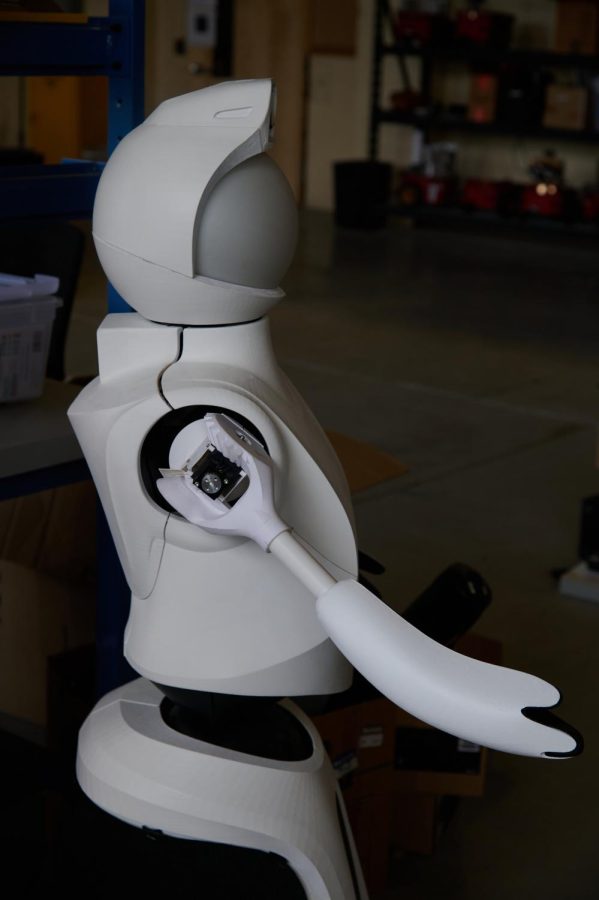Oregon State University leads $5M project to standardize robots
Researchers to work alongside University of Pennsylvania and Semio
The Quori robot sits on the second floor of Oregon State University’s Graf Hall on May 31. This robot was created by Professor Naomi Fitter and her students and they are working to make them more accessible to research groups.
July 3, 2023
While Future Leader of the Resistance in the “Terminator” franchise John Connor may have been born in 1985, his main adversary has yet to be created in the present day.
However, as of late April, researchers at Oregon State University have joined in one such project that seeks to help push that adversary — robots — to get more advanced, through standardization of robots for the research community.
The $5 million project is being done through the National Science Foundation with OSU College of Engineering professors Bill Smart and Naomi Fitter using Quori robots which are “Community-Driven Modular Research Platforms,” according to an OSU press release and the Quori website.
This project is a continuation of the research done previously by NSF with the University of Pennsylvania, software company Semio and the University of Southern California. The three designed, built and tested 10 prototype Quori robots.
According to the press release, OSU and the collaborating research groups will be working to improve the design of the robots as well as to make them easier to manufacture so that more research groups can get their hands on them as well.
According to Fitter, there is a reproducibility crisis that can be found both in psychology and increasingly in robotics.
“Some results from certain labs or even your famous classical results, things you might have heard of, from popular culture in psychology results, like the Stanford Prison Experiment — it turns out that many of these famous results don’t replicate,” Fitter said.
The 10 prototype Quori robots were awarded to various universities across the nation, with one landing at OSU.
OSU’s original proposal for the usage of the Quori robot ranged from research into using robots and automation in treating highly infectious diseases, to studying long-term privacy concerns raised by using such such robots as the Quori robot, according to the Quori community updates page. The NSF project is now one more thing on the list of uses the Quori robot will be having for the university.
When it comes to the timing of the project, the NSF grant is good through 2027 according to Fitter.
“Ideally, we’ll go through a design update process, find a contractor to scale up the robotic platform, circulate it to different university communities and build a community around the robotic platform within that time span,” Fitter said.
While the work of Fitter and the other collaborators may be on what is considered the cutting edge of robotics, the same cannot be said about the hall that the robot is stored in.
Graf Hall, named after OSU Agricultural College Graduate Samuel H. Graf, was built in 1920 and was called the Engineering Laboratory until 2015. Alongside the rename in 2015 came the addition of a robotics research area where the Quori robot is currently housed.
Despite being research carried out in a laboratory at a public research university, the NSF grant for this particular project is not going to have student support.
“Compared to your typical National Science Foundation grant, where a lot of the time student training (and) student support is a big priority, in this one, the priority is a little more infrastructure development,” Fitter said.
Currently, OSU students have been and still are able to use the Quori robot for existing projects, however. The difference is that the purpose for allowing students to use the robot is more rooted around putting together a community around the robot, Fitter said.
“Considering we’re the ones that work with the robots the most, I guess our feedback would be helpful in it. All we can do is assume the professors know best,” said OSU robotics major Triniti Armstrong.
On the actual goal and purpose of the research, both Armstrong and fellow robotics major Ayan Robinson agreed the work was still a great idea.
Armstrong added that they both have a lot of problems with robots simply not working because of operating systems being expired.
“A lot of the time we’ll try to work with something, and it won’t necessarily work for what we have because they use a different software, a different program, different connections,” Robinson said.











































































































